

 The South African
The South African
Parts I and II in this series appeared in Vol.2 No.1, June 1971
INTRODUCTION
Just as the Spanish Civil War provided a testing ground for German
and Italian equipment before World War II, so did the South African War
provide a similar opportunity for the proving of French and German Artillery,
with which the Boers were equipped.
These guns were superior to those being used at the time by the British Army. At the beginning of the war, British Artillery was frequently outranged by Boer Artillery, and British gunners were surprised at the way in which the Boers moved their heavy guns about the countryside.
These developments required rapid action by the British. In an age not
normally known for quick thinking and efficient action, these qualities
were nevertheless displayed by the Royal Navy as they rapidly adapted their
guns for service in the field.
Boer Artillery consisted of a mixture of obsolete guns and
the latest that Europe had to offer. There were several different types
in use. For example, by October 1901 the British had captured as many as
21 different models. In addition, numbers were increased by guns captured
from the British Army.
Guns were used in typical Boer fashion. They were usually deployed individually. They were seldom organised in batteries and, more often than not, they were simply used as long range rifles. There was little co-ordination between guns, and this made the concentration of fire on specific targets very nearly impossible.
Cover was used skilfully, and the Boers made the most of the superior range (in most instances) of their guns. They would hold their fire until the enemy had been lured into an ambush. Their guns did not normally require an escort, as they would be withdrawn if the enemy got too close. The Boers were reluctant to risk their guns in the open. Being outnumbered 4:1 by the British Artillery, this caution was understandable.
It is not possible to cover here the complete range of Boer guns. This review is restricted to those acquired from Europe shortly before the war, and which were most prominent on the battlefield. These were:
75 mm Creusot QF
75 mm Krupp QF
120 mm Krupp Howitzer BL
155 mm Creusot BL
37 mm Maxim Automatic Machine Gun ('Pom-Pom')
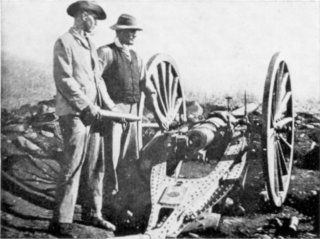
75 mm Creusot QF - the sights are prominent.
The rear tangent sight
has a moveable
cross-head to allow for deflection for wind, etc.
| Calibre | 75 mm/2.95 in. |
| Weight of gun | 7 cwt |
| Weight of gun carriage packed | 20 cwt 1 qtr 1lb |
| Weight behind the gun team | 35 cwt 2 qtrs 12 lbs |
| Ammunition | Common, shrapnel, case |
| Weight of shell: Common | 11 lbs 8 ozs |
| Weight of shell: Shrapnel | 14 lbs |
| Range: Time fuze | 6,800 yds |
| Range: Percussion | 6,800 yds |
This was a pioneer of modern QF equipments. It was specially designed to give a far-reaching zone of shrapnel effect, and so it had a flat trajectory and high MV (1951 ft/sec for common shell compared with 1574 ft/sec for the 15 pr). However, this MV strained the carriage. The buffers gave trouble and these guns were often in need of repair.
Mention of the buffers is a reminder that this gun had a proper recoil system which was still unusual at this time. The function of a buffer is to absorb the force of recoil. The Creusot's hydraulic buffer allowed 11.5 ins of recoil. This was insufficient, so an axle spade and drag shoes were also fitted to help control recoil. Spring recuperators then returned the gun to the run-out (normal) position.
Also unusual for guns of this period was a traversing system. This allowed two degrees traverse either way.
The gun had a high rate of fire of 10 rpm. Shrapnel and common shell were of different weights and this caused them to range differently. At 11.5 lbs common shell was too light for this calibre gun. On the whole, ammunition proved unsatisfactory.
The centre of gravity was low and cross country performance was good.
Although the gun had its weak points, in design principles it was ahead of its time. Its successor, the famous French '75' of World War I, was generally considered to be the best gun of that war. To a large extent, this resulted from the battle-testing of the 75 mm Creusot in the Boer War.
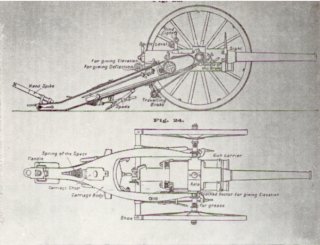
75 mm Creusot QF - the top drawing
illustrates the low centre of gravity.
| Calibre | 75 mm/2.95 in |
| Weight of gun | 4 cwt 2 qtrs |
| Weight of gun carriage packed | About 104 cwt |
| Ammunition | Common and shrapnel |
| Weight of shell Common | 13 lbs 8 ozs |
| Weight of shell Shrapnel | 11 lbs |
| Range: Percussion | 4,400 yds |
| Note: These are The Times figures. Other reports give maximum ranges as follows: | |
| Range: Time fuze | 3,850 yds |
| Range: Percussion | 6,600 yds |
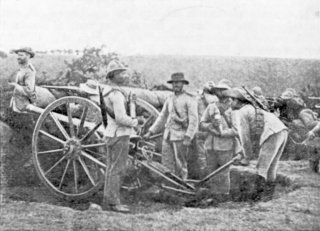
75 mm Krupp QF - the gun is being laid
for line by the man on the right.
Krupp guns were identifiable by their horizontal sliding block breech systems, whereas the French Creusots had the interrupted screw system. The sliding block method is in use to this day in modern QF equipments. As it does not provide as effective a gas seal as the other, a cartridge case is used to help in obturation, i.e. to prevent the escape of gases to the rear. This system does, however, allow a rapid rate of fire.
Krupp ammunition was said to be more trustworthy than that of the Creusot. Shrapnel was of cast iron and, therefore, held fewer bullets (103 compared with 234).
The carriage was rigid with no buffer.
| Calibre | 120 mm/4.7 in. |
| Weight of gun | 8 cwt 3 qtrs |
| Weight of gun carriage packed | 19 cwt 1 qtr 15 lbs |
| Weight behind the gun team | 35 cwt 3 qtrs 10 lbs |
| Ammunition | Common, shrapnel, case |
| Weight of shell | 35 lbs |
| Range | 6,300 yds |
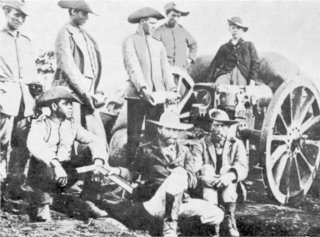
120 mm Krupp Howitzer QF -
the horizontal sliding breech block
and the distinctively angled
traversing handspike mark this as a Krupp.
Although shell weight was light for the calibre, accuracy was good to 6,000 yds. The gun had the normal Krupp horizontal sliding block. The carriage was a plain, rigid one with no buffer. It was considered to be a good gun.
It should be noted that, although a howitzer, it nevertheless outranged
British Field and Horse Artillery.
| Calibre | 155 mm/6 in |
| Weight of gun | 49 cwt |
| Weight behind the gun team | 108 cwt |
| Ammunition | Common, shrapnel, case |
| Weight of shell | 94 lbs |
| Range | 11,000 yds |
This was a 'Gun of Position' in the terminology of the time. It was destined for the fixed defences of Pretoria and Johannesburg. It was intended for use on a wooden platform, the carriage being connected to a pivot plate on the platform.
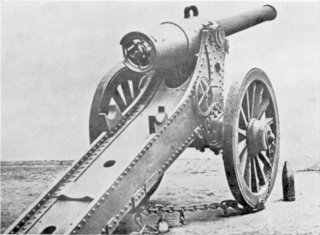
155 mm Creusot BL ('Long Tom') -
note the fittings on the trail to
receive the trunnions when the gun
was prepared for movement.
The Boers, however, decided to take their 'Long Toms' into the field. This they did with considerable success, surprising the British Army with the skill and efficiency with which they moved them about. This mobility was aided by the ability to move the gun to the rear along the carriage, and by the provision of a further pair of wheels to help take the weight (as illustrated).
It should be pointed out that this was not the first time that 'Guns of Position' were used in the field. During the Franco-Prussian War of 1870/71 the fortress guns of Belfort were removed and used in the fighting on the Lisaine.
The 'Long Tom' outranged the guns the British deployed in the early stages of the war. At first the Boers had difficulty in using the shrapnel properly, but the fuzes were modified and later they got good results at about 10,000 yds.
Boer ingenuity was also displayed in the repair of a 'Long Tom' which was damaged at Ladysmith. A new breech block was made for it and the damaged barrel was cut short and, with efficiency only slightly impaired, it was returned to the field.
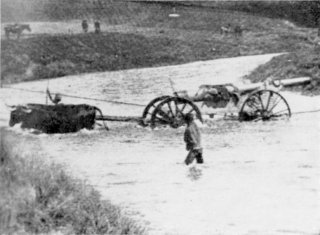
155 mm Creusot BL ('Long Tom') -
crossing a river in Natal.
| Calibre | 37 mm/1.5 in |
| Weight behind the gun team | 27 cwt |
| Ammunition | Explosive rounds |
| Weight of round | 1 lbs |
| Range | 3,000 yds approx |
This was simply a large, belt-fed machine gun, firing explosive rounds. The moral effect was considerable although the material effect was small. The aggravating bark, coupled with the fact that one burst meant more were on the way, was trying on the nerves. Light and easily concealed, it did not throw up a cloud of dust when it was fired. It fitted in well with Boer methods. It was the only gun in South Africa fitted with a shield.
The 'shells' were cast iron, filled with powder and fitted with a nose percussion fuze. They were fixed in brass cartridge cases and 25 of these were placed in a belt. The limber carried 12 of these belts.
The 'Pom-Pom' was taken into service with the British Army, and will appear again in Part 6 of this series.
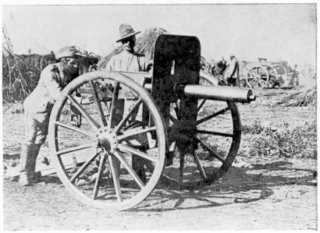
37 mm Automatic Machine Gun ('Pom-Pom') -
the only equipment
in South Africa with a shield.
It was soon appreciated that Boer Artillery outranged British
Artillery. Immediately a call went out to the Royal Navy to provide guns
and detachments to redress the balance. Although the heavier guns of the
siege train would provide an answer to the enemy's guns, they were not
due to arrive in South Africa until the New Year.
In a remarkable display of ingenuity, guns were provided with makeshift field carriages or mountings, and were despatched to the battle-front.
These guns were invaluable. Their relatively long ranges provided an answer to the Boer Artillery. It was with some justification that the Royal Navy claimed that the 4.7 was the gun which saved Ladysmith. Even if this was a slightly exaggerated claim militarily, there is no doubt that the moral value of the Naval guns was of the greatest importance.
Prominent at this critical moment was Captain Percy Scott of HMS Terrible. He was largely responsible for adapting the Navy's guns for land service.
Early in 1900 the Royal Garrison Artillery arrived in strength with the siege train, and with additional men to relieve the sailors who were able to return to their ships.
Naval guns deployed ashore were:
12 pr 8 cwt
12 pr 12 cwt QF ('Long 12')
4.7 in QF
6 in QF
| Calibre | 3 in |
| Weight of gun | 8 cwt |
| Weight of shell | 12 lbs approx |
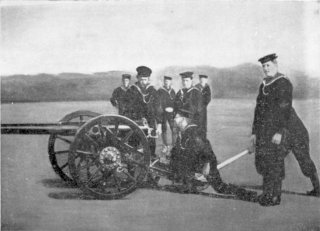
12 pr8 cwt QF -
a good illustration of a gun being laid;
while one man operates the
traversing handspike to the
other's directions, the latter
also lays carefully for elevation
as he looks along the sights.
This was the normal artillery equipment of naval landing parties and there was, therefore, no need to design an ad hoc carriage for it. It had a short range and a light shell, and was not very effective. Nevertheless, it played its part in the early stages of the war in Natal.
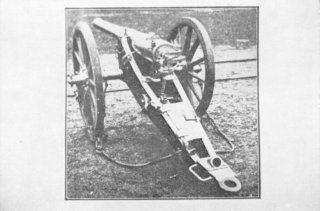
12 pr8 cwt QF - drag shoes have been fitted.
Elevation is by arc and pinion.
| Calibre | 3 in. |
| Weight of gun | 12 cwt |
| Ammunition | Common, shrapnel, case |
| Weight of shell Common | 12 lbs 8 ozs |
| Weight of shell Shrapnel | 14 lbs 1 oz |
| Range Time fuze | 4,500 yds approx. |
| Range:Percussion | 9,000 yds approx. |
The carriage for this gun was designed by Captain Scott. The design was completed and the first gun mounted in less than 48 hours. The trail was a 12 ft long log beam -- the wheels were wagon wheels. Drag shoes were fitted to limit recoil, although the gun also had an oil and spring buffer.
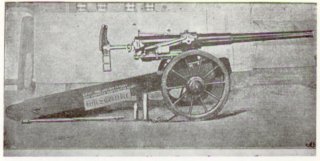
12 pr8 cwt QF - this illustrates clearly
the carriage designed by Captain Scott.
Although the makeshift carriage was sufficient to get the gun into the field, there were various flaws. The wheels and axles were all of various types and, therefore, not interchangeable; and most were too narrow and high which caused several to overturn on difficult ground. There were no brakes and wheels had to be lashed until brakes could be devised. If the gun was elevated over 7,000 yds, the oil cylinder hit the trail and pits had to be dug. But there was seldom any trouble with the gun itself.
In spite of these problems, full credit must be given to Captain Scott
for producing a workable carriage at such short notice. The 'Long 12' performed
yeoman service in Natal and the western theatre where it boosted the fire
support available from the Royal Artillery.
| Calibre | 4.7 in |
| Weight of gun | 2 tons 2 cwt |
| Weight of gun carriage packed | 6 tons approx. |
| Ammunition | Common and shrapnel |
| Weight of shell | 45 lbs |
| Range: Percussion | 9,800 yds (Navy and Army III) |
| 12,000 yds at 24 degrees (Burne) | |
| Time fuze | 6,500 yds |
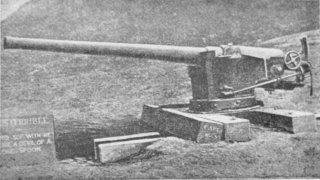
4.7 in QF - the two guns in Ladysmith
fired from platforms such as this.
Both a wooden beam platform and a travelling carriage were designed by Captain Scott. The former is similar to the 'Pile platform' produced for semi-mobile 3.7 in AA guns in World War II. When there was no requirement to move the gun, this platform was quite adequate, and the 4.7 mounted like this was invaluable in the Defence of Ladysmith, where its range was needed to counter the Boer 'Long Tom'.
On its mobile carriage the 4.7 performed well with the army in the field. Weighing more than the 'Long Tom', and with all its weight bearing on one pair of wheels, it was more difficult to move than that gun. On occasion as many as 32 oxen were required to move the 4.7.
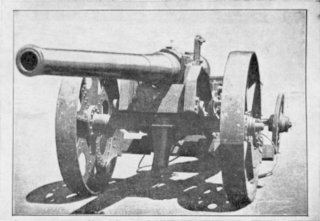
4.7 in QF - mounted on
Captain Percy Scott's mobile carriage.
The construction of the travelling carriage was very simple. The large timber beams forming the trail were needed to provide stability with their weight and to prevent the gun overturning on recoil. Drag shoes were also used, and the carriage was attached by cable to a strong point in front of the gun to help control recoil.
With the arrival of the Army Corps, some of these guns were handed over
to the army and others were returned to the navy.
| Calibre | 6 in |
| Weight of gun | 7 tons 8 cwt |
| Weight of gun carriage packed | About 11.5 tons |
| Ammunition | Common and shrapnel |
| Weight of shell | About 100 lbs |
| Range | 15,000 yds at 28 degrees |
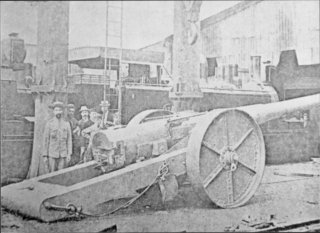
6 in QF - this gun joined Buller
just before the Tugela Heights battles.
Captain Scott received an urgent request from General Buller for a naval gun with an even greater range than those which he had already provided. The request came on a Wednesday; by the following Monday this gun was ready on a field carriage. It appeared on the Natal front a fortnight before the Relief of Ladysmith.
Two 6 in guns were put on rail mountings by the Royal Naval Dockyard, Simonstown, assisted by the Cape Government Railways. These guns could be fired broadside to the line, and they appear to have been very successful. A few rounds were fired at Magersfontein, one of the guns was at Fourteen Streams before the Relief of Mafeking, and both were used on several occasions during the last year of the war in the Orange Free State.
The guns were fired at all ranges from 3,000 yds to 12,000 yds. The larger angles of elevation were achieved by firing sidings which were inclined upwards to the front. The range of 15,000 yds was reported of the gun on a field carriage operating in Natal.
Common shell and shrapnel were fired. In the words of a contemporary report, 'the burst of a 100 pr shrapnel appeared to leave little to be desired.'
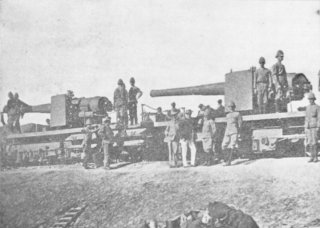
6 in QF - these Naval guns
on rail mountings were manned
by men of the
Royal Garrison Artillery
who were already in South Africa
at the outbreak of war.
Return to Journal Index OR Society's Home page
South African Military History Society / scribe@samilitaryhistory.org